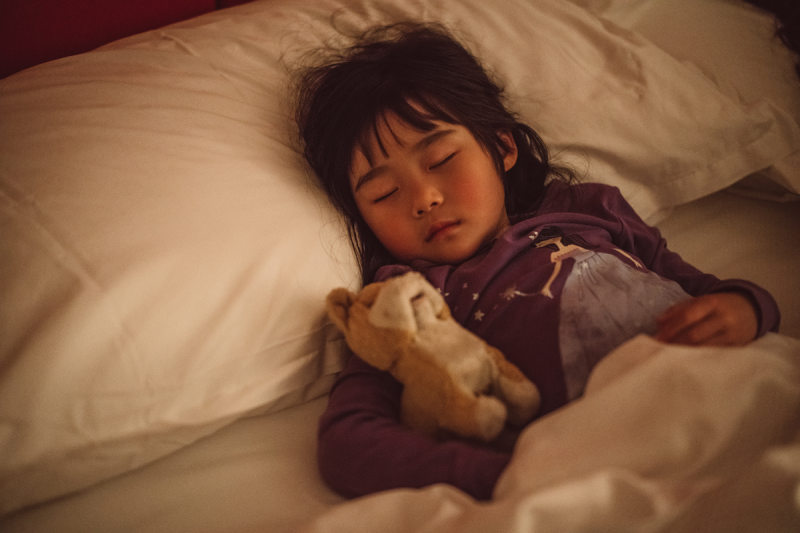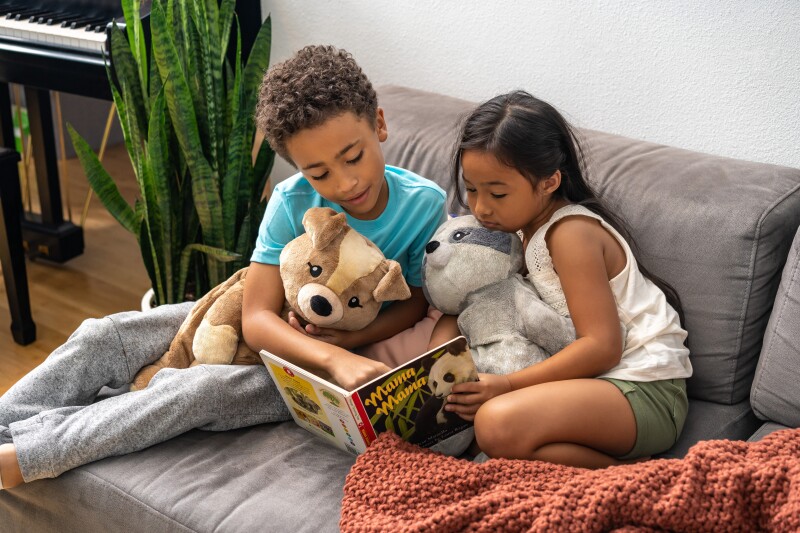As we all feel the weight of the world, many of us are turning to weighted objects to help feel grounded at bedtime.
Past studies of weighted blankets have shown they may decrease anxiety and potentially ease insomnia. The hug-like feeling was shown in a 30-person study published in 2020 in the journal Sleep to promote relaxation, lower stress, and improve sleep. These benefits have been shown in several studies to help those with autism and attention deficit/hyperactivity disorder (ADHD).
Kids and adults alike have also sought comfort in the fuzzy arms of a stuffed animal. After all, stuffed animals can help kids and adults feel less anxious and more calm and secure at bedtime. Not only is a stuffed animal an item to hold, but it can also be a transference object, enabling children and adults to feel companionship and a feeling of emotional wellness.
So, in a quest to combine the best elements of both worlds, a new market has emerged for weighted stuffed animals, combining the best of both. Warmies can be heated in the microwave and are infused with lavender. Chonkers, which ran a successful Kickstarter last year, sells an oversized stuffed bear that can be customized to different weights. And the floppy-eared Moon Pals are bright-colored characters with arms that fold around you.
Hugimals, launched earlier this year by Marina Khidekel, include four different stuffies that could be used by children or adults.
“I created Hugimals as a solution to my own anxiety-driven insomnia,” said Khidekel, a health and wellness editor. “Hugimals combine the physical calming effects of a weighted blanket with the emotional connection of a favorite stuffed animal.”
When it comes to a weighted stuffed animal, Dr. Chris Winter, Sleep.com Advisor, neurologist, and author of “The Rested Child,” notes that the “weight and pressure may help some find comfort or relax.”
When creating Hugimals, Khidekel relied on the expertise of doctors, occupational therapists, and product designers to land on the ideal size and a neutral facial expression to “support a range of emotions in a no-judgment zone.” Each plushie has a weighted insert, which can be removed when you want to wash the stuffed animal’s fur.
Hugimals and weighted blankets both simulate the feeling of being held. The weight, and accompanying pressure, matches the sensation of being hugged. “The grounding feel of the weight helps people feel comfortable, calm, safe, and secure, which can also lead to falling asleep easier,” said Khidekel.
A weighted plush sleep companion for all ages
For Khidekel, the invention of Hugimals stemmed from her own struggles with sleep. She used to rely on her partner’s arm as a comforting weight but knew that this sleep position wasn’t sustainable for her or her partner.
While the pressure of weighted blankets was calming, they weren’t the answer either. “I’d wake up in the middle of the night overheated, kick off the blanket, and spiral once again in my anxious thoughts,” explained Khidekel. “And even if I wanted to travel with or wash it, I couldn’t because it was too cumbersome.”
In the search for something between an arm and a blanket, she dived into the world of weighted stuffed animals while covering the New York Toy Fair but didn’t like the products already on the market and was keen to find something that could appeal to all ages.
“Many adults have told us they wanted a weighted plush for themselves,” said Khidekel. “I couldn’t find what I was looking for, so I made one.”
How it felt to try a Hugimal
I was curious to see if my family could find comfort in a cuddly bear. So, I purchased one to try.
Darby the Bear, at about four and a half pounds, is a two-handed cuddle (there are also Sam the Sloth, Emory the Elephant, and Charlie the Puppy). He’s a bit slumpy, in an endearing way. It’s hard to resist slinging him over your shoulder like a baby. His fur is soft and he’s got more weight than I expected. It feels good to hug this bear.
When Darby the Bear arrived, I expected our 10-year-old son, who often sleeps with a weighted blanket, to claim it first. But our 13-year-old daughter snagged the “lumpy bear,” wondering “why he was so heavy.” She bemoaned that his legs were flat and that she had to hold him like a baby, but her attitude toward Darby was different in the morning.
“I felt safe,” said my daughter about sleeping with the bear. “He felt like an anchor. The only downside was I kept losing my grip on him in the middle of the night and it was so much work to try and grab him again.”
Over the course of a week, Darby made his way around our house. I’d find him slumped against my daughter’s pillow or facedown on the couch like a bear who had a few too many hugs last night.
Both kids would clutch him unconsciously while watching television. A recent study showed that “self-soothing touch” reduces our cortisol (the primary stress hormone) response to stress.
My son had a few false starts with Darby at night. He found sleeping with a weighted stuffed animal to be uncomfortable. As someone who regularly has to shove a dog or cat over to sleep, I understood completely.
As I carried the floppy bear out of my son’s room, my wife paused.
“I haven’t seen you hold anything like that since the kids were babies,” she said.
“It feels natural to hold him this way,” I said, patting the bear’s bottom.
A few minutes later, our daughter walked into our bedroom. And, in the way of teens, silently picked up the bear and left. An hour later, I went into her room to say goodnight and found her with both arms around Darby, snoring softly.







